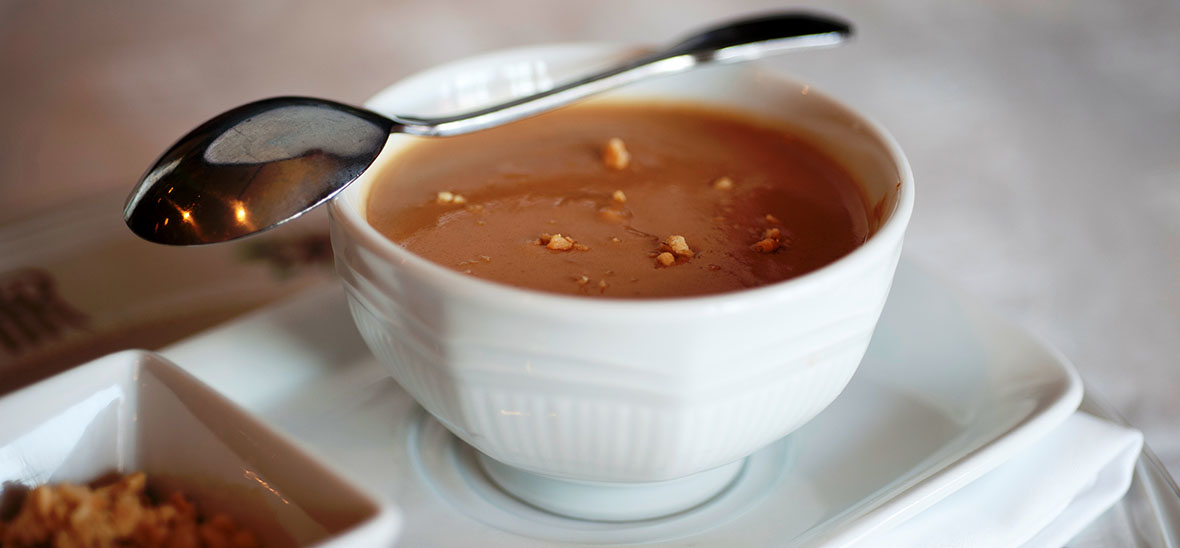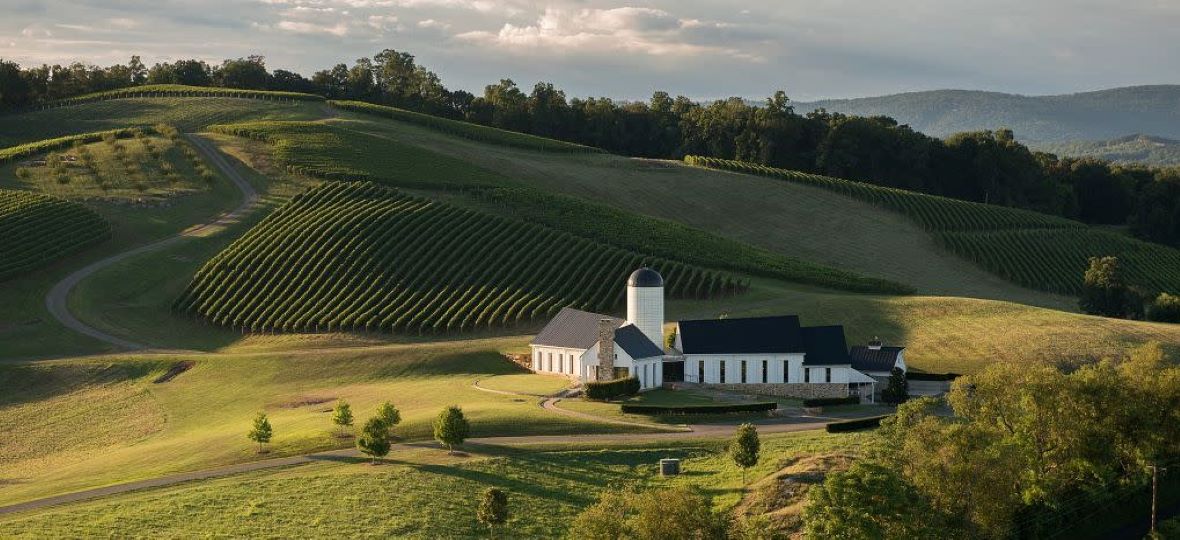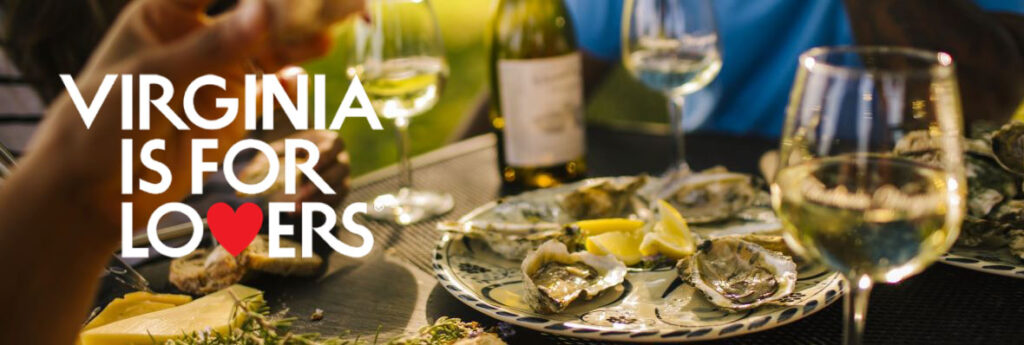From famous seafood and country ham to dessert delights like fruit cobblers and homemade pies, visitors to Virginia can expect a mouth-watering experience based on fresh produce, fabulous chefs, and a wealth of culinary creations unlike anywhere else.
And then there’s the wine, cider, craft beer, and spirits, including a lengthy list of local libations that can not only be savoured, but discovered, through experiences ranging from eclectic farm and production facilities to unique themed trails that reveal the countryside and locales that inspired them.
Any accounting of Virginia delicacies starts with oysters, with the state being dubbed the “oyster capital of the east coast” and featuring eight distinct regions across Chesapeake Bay and its tributaries, each with its own qualities. Eaten direct from shell, in five-star recipes, and all fashions in between, oysters are ubiquitous again after intensive conservation in recent decades helped the state’s industry recover from pollution and overharvesting.
And travellers can eat oysters year-round thanks to numerous festivals and events, like traditional Chesapeake Bay oyster roasts. Marquee Virginia oyster events include the Urbanna Oyster Festival, the Chincoteague Island Oyster Roast, The Merroir and Terroir Oyster Roast, and even more at restaurants, wineries, and breweries.
The state, perhaps unexpectedly, is also known for its peanut culture with Virginia’s Canadian tourism representative Bri Bélanger-Warner advising that trying peanut soup is definitely not nuts. “It’s something really unique that you wouldn’t think of, but it’s really delicious,” she says. (Peanut pie is also a possibility).
The state also boasts its own brand of barbecue. “A lot of people think of Carolina or Texas barbecue, but there is such a thing as Virginia barbecue and you can find it throughout the state,” Bélanger-Warner says.
While recipes vary from region to region, Bélanger-Warner, recommends her very own local – the Barbecue Exchange – in Gordonsville (near Charlottesville). “It’s an amazing place,” she says. “Of course (the chef) smokes all his meats on the premises. It’s just melt-in-your-mouth type food.” A second satellite location is also located at the James Madison Montpelier estate in Orange County.
Perhaps even more ubiquitous than barbecue is fresh produce, including all types of fruits and vegetables. “Generally speaking,” Bélanger-Warner says, “because our climate is quite mild, we have agriculture going year-round” – an opportunity taken advantage of by a burgeoning roster of talented chefs in the state, including in the culinary capital of Richmond, where numerous new restaurants and breweries have opened this year, including Hatch Local Food Hall, a curated collection of local food vendors in the Manchester neighbourhood.
“So, you eat really fresh, you eat local food; the farm-to-table movement is huge and had been huge even before it became a trendy thing to promote. It has been a way of eating for a very long time,” enthuses Bélanger-Warner.
Virginia chefs have also made their mark on the national stage, as James Beard-nominated restaurants and bakeries can be found from coast to cliff. From award-winning fine dining to down-home Southern cooking at family-run restaurants, there’s something for every type of foodie.

5 things to eat in Virginia
• Seafood: Beyond oysters, there is no shortage of seafood to sample in the state, from blue crabs to clams, sea scallops, croaker, striped bass, flounder, catfish, and many other species of fish. Another regional delicacy is She-Crab soup, a hearty bisque chock full of blue crab meat.
• Virginia ham: Famous since the 17th century, local country hams are hickory smoked, cured with salt, and aged for months to create a distinctive flavour. Best known is the Smithfield brand, which by law must be cured within the Smithfield town limits. And don’t forget the ham biscuits.
• Brunswick stew: Several locations in south-eastern states, including Virginia’s Brunswick County, claim to have first developed this tasty, savoury stew, which features vegetables and meat in a tomato-based sauce. While squirrel is said to be a historically preferred ingredient, modern diners are more likely to be served chicken and/or pork. (Note: Brunswick County has launched the Brunswick Stew Tour, a new tourism initiative that highlights the “world-famous” dish and showcases local businesses in the county on the North Carolina border).
• Macaroni and cheese: Thomas Jefferson may have signed the US Declaration of Independence, but foodies will consider the former president’s greatest achievement to have been bringing back a pasta machine from Europe in the 1790s, sparking a macaroni and cheese revolution that is alive and well in Virginia today.
• Chess pie: Known throughout the South, Chess pie is Virginia’s most iconic dessert, having reportedly first appeared in the 1824 cookbook “The Virginia Housewife.” Typically, the tasty tart has a custard filling, and variations include buttermilk, chocolate, lemon, and nut. The origin of the name is unclear, but one theory is that it was a preferred snack for men after a game of chess. But not to worry, for modern diners, chess is definitely not required.
Drinks & Libations
Just like the food, Virginia-crafted beverages have a deep history dating back to the country’s first settlers, with wine, brews, ciders, and spirits more than 400 years in the making.
Visitors can taste internationally acclaimed vintages with backdrops ranging from rural mountain estates to the coastal plains of the Eastern Shore. Craft beer towns that come alive with live music and local food trucks, and seasonal ciders and crafted cocktails can be sipped at local orchards and distilleries all across the state.
• Craft beer: Virginia is truly for Craft Beer Lovers, with more than 300 craft breweries offering locally inspired brews to guests ranging from dedicated beer aficionados to those simply needing to quench their thirst after a hike or bike ride. Many localities have created self-guided craft beer trails linking several breweries all located with a few miles of each other, while guided brewery tours, festivals, and other events provide lively opportunities to discover the scene. Thankfully, it makes for thirsty work indeed.
• Distilleries: Virginia is the Birthplace of American Spirits – the first batch of whiskey was distilled in 1620 and George Washington was the biggest producer of Virginia whiskey during his time, producing more than 11,000 gallons in 1798 alone. Today, Virginia has close to 40 distilleries where visitors can learn about the distilling process firsthand, while sipping and savouring batch spirits and craft cocktail samples and meeting the craftsmen and women who are guardians of the state’s history of Virginia’s brandy, whiskey, and gin.

• Wine: Virginia’s wine industry has grown by leaps and bounds in recent years both in prestige and in numbers of wineries (over 300 and counting) with locations in nearly every part of the Commonwealth. Visitors (and locals) will find many wine and food festivals and there are 16 distinct and well-marked wine trails, ranging from Heart of Virginia Wine Trail to the Shenandoah Valley Wine Country Trail – all of which encourage discovery of local grapes and gourmet cuisine, and show off the state’s gorgeous countryside along the way. The most planted grape is Chardonnay, though Cabernet Franc and Viognier are also well represented throughout the region, and, of course, many wineries welcome visitors for tours and tastings, typically in spectacularly decorated tasting rooms, and often with onsite restaurants as well.
• Cider: Virginia’s cider scene has also exploded over the past few years, with makers crafting innovative beverages that honour the Commonwealth’s rich history while looking to new trends, tastes, and styles. Cider styles vary from dry to sweet, still to sparkling, simple to complex, and visitors will find more than 20 cideries throughout Virginia to try them.
5 places to taste Virginia
There are countless food and drink getaways, both packaged and self-guided, and from farms and rural B&Bs to inns and city hotels, throughout the state. Here are five unique options:
• Southern Revere Cellars in Louisa is a family owned and operated farm brewery and winery located on 70 picturesque rolling acres. They offer an approachable gathering spot for family and friends in a modern rustic tasting room and covered patio with a farm, pond, vineyard, and hops field. In addition, there is an onsite “farm to table” style business on location.
• George Washington’s Distillery & Gristmill, located 5 km from the Mount Vernon estate, still produces Washington’s famous Rye Whiskey using his 18th-century recipe and methods. While the site has begun doing limited spirits tastings, visitors will be able to enjoy a new, permanent tasting room on the property in 2022.
• Central Virginia’s Stable Craft Brewery, an authentic working farm, brewery, and winery, has undergone improvements and renovations including tripling its covered patio space, the addition of a new outdoor bar and dining decks, and new fire pits. Other recent improvements include the brewery’s new signature Diamond T Outdoor stage for live music, outdoor dining igloos, outdoor pavilion spaces, and a new nine-hole outdoor cornhole golf course to allow visitors to enjoy the great outdoors while enjoying cider or beer.
• Highlands Distilling, in southwest Virginia, is a new craft spirits distillery that offers small batch whiskey, bourbon, moonshine and gin at its tasting room in Marion.
• Up north, Potomac Point Winery & Vineyard recently expanded in what is known as ‘Merlot Meadow,’ which provides a wide variety of new experiences including an outdoor tasting lounge, firepits, bocce ball, and picnic areas. The Meadow provides a great variety of activities that can be reserved to accompany the wine tasting experience.
FAST FACT
Virginia is now recognized for eight American Viticultural Areas (AVAs) with the recent addition of the Virginia Peninsula AVA. Bound by the James and York River estuaries, the narrow AVA runs about 80 km in length, toward Richmond, making for a unique growing region for a few of Virginia’s hundreds of wineries.

